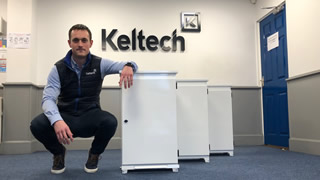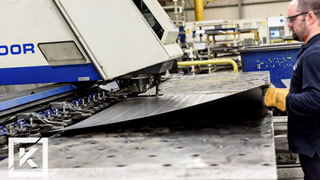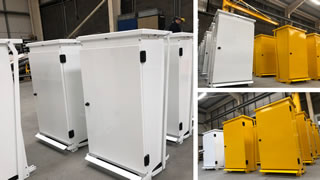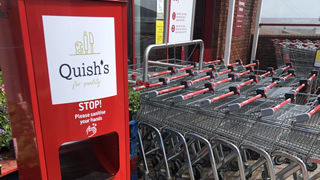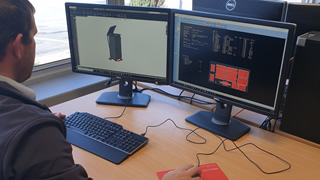Keltech’s Hat Trick of Equipment for Front-Line COVID-19 Battle
RADAN’s role for medical waste bins, hand sanitisers, and acoustic enclosures
A Waterford sheet metal specialist used RADAN software to prototype and manufacture emergency medical waste bins for the Irish health service in the fight against COVID-19. And the company has now developed a unique hand sanitisation station capable of dispensing 6,000 shots of gel before needing to refill the unit’s four-litre tank.
Keltech have traditionally been experts in three main industrial sectors: reservoir, hydraulic and fuel tanks; overhead guards and cabins for equipment such as forklift trucks; and acoustic enclosures for the power generation industry.
"RADAN is excellent at optimising each sheet. We can see exactly where we are with the nests, and how they can be improved if we need to use a larger blank to add more components, or a smaller blank if there are fewer parts."
Sean McNamara, Senior Projects Engineer
The idea for the bins came after one of their power generation customers needed to supply both the NHS and the Irish Health Service Executive (HSE) with emergency diesel generators at temporary patient care and COVID-19 testing sites. “We stayed open to manufacture the acoustic enclosures to reduce the noise of the generators, but that was only taking around 30 per cent of our machining capacity,” says Business Development Manager Seamus Lawlor.
“So we approached the HSE to offer support by manufacturing medical waste bins, as we had the in-house CNC cutting tools, RADAN software to drive them, and the necessary expertise to rapidly prototype a product in keeping with the spec they required. Their reply was almost instantaneous…saying bins were in huge demand globally, and they were having difficulty sourcing them.”
The initial prototype was built in seven days, and the first production batch, based on the fourth version, came off the CNC machines three days later. They’ve now gone on to manufacture around 500 a week from two different material specifications, depending on the particular application; one is a stainless steel version, while the most popular is a mild steel, powder coated, unit.
Each bin comprises around a dozen individual components, with RADAN creating optimum nests to maximise the yield from each sheet and avoid wastage. Senior Projects Engineer Sean McNamara says the company buys a considerable amount of sheet metal and need to utilise every piece. “RADAN is excellent at optimising each sheet. We can see exactly where we are with the nests, and how they can be improved if we need to use a larger blank to add more components, or a smaller blank if there are fewer parts.”
One of their biggest challenges was the opening and closing mechanism for the lid, but RADAN’s ability to quickly edit the toolpaths and amend the programs was crucial in speeding up the process. “For instance, where we needed to change the position of holes we could do that quickly and accurately.”
And Seamus Lawlor says the foot-operated opening system means staff don’t need to touch the bin lid. “The lid itself, when closed, is perfectly sealed, ensuring the potentially contaminated waste is secure. It’s also designed with a silent close feature so as not to disturb patients. The front opening door allows staff to easily change bags…and we use state-of-the-art glossy powder paint which will give a good, easy to clean finish, so we expect the bins to last for between 10 and 15 years.
“This was more of a mission to support the urgent COVID-19 requirements of the HSE rather than looking at the product as a long-term business model, but private companies are now coming to us wanting these bins for places such as nursing homes and other care centres. We’re getting interest from the UK, mainland Europe, and the United States.”
With RADAN able to program both their Trumpf laser cutter and punch press, the decision as to which parts are cut on which machine rests largely on profiling criteria, based on the component’s curves. “It’s difficult to produce curves on the punch, so those parts would be lasered.
Keltech has also developing a third product to continue the long-term battle against Coronavirus. “We’ve rapidly prototyped a hand sanitising unit, which we believe is unique because of its large tank. It’s predominantly for high footfall retail areas, and we’ve already had a number of orders for it from major brands.”
Sean McNamara and his team have developed an internal tank, nested and cut using RADAN, which can hold four litres of sanitising gel, giving the unit one of the largest capacities on the market, able to dispense around 6,000 shots before it needs to be refilled.
Seamus Lawlor concludes: “This means low maintenance for retailers, even in a high-usage, high footfall area, and is a complete game-changer from traditional units on the market. Early customer feedback is extremely strong and positive – they say they can now buy sanitiser gel in bulk and the units are so easy to refill; busy supermarkets with high footfall have only had one refill after a fortnight; and they say the units ‘look great and are a real addition to their brand.’”About the Company
Name: Keltech
Business: Sheet metal subcontractor
Web: www.keltech.ie
Benefits Achieved
- Initial prototype completed in seven days
- Easy programming for both laser cutter and punch press
- Quick and easy editing of toolpaths and programs speeded up the manufacturing process







